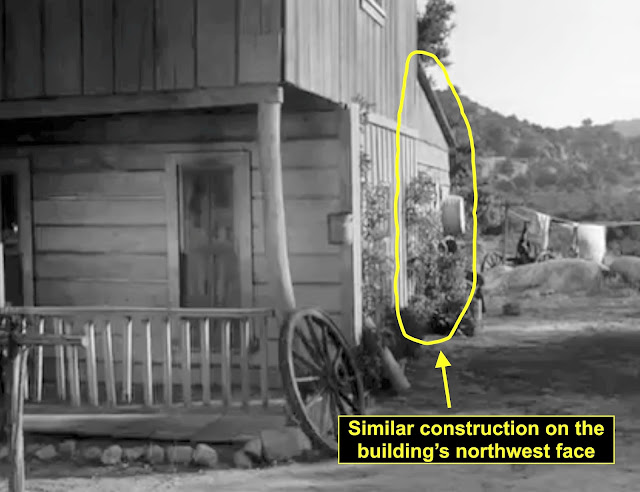Saddlehorn Relay Station, ca. 1939-1940 (click here for an update)
This behind-the-scenes photo surfaced recently showing the building known as the Saddlehorn Relay Station. Believed to be from late 1939 or early 1940, the photo holds clues to the structure's origin.
The building has a sign on it declaring it to be the Squaw Creek Relay Station. The man at the left is probably a crew member on the (previously) unknown production.
A zoomed-in version of the shot offers a better look at the sign, although a cowboy's black hat blocks part of the word "Station."
The relay station was located on the Lower Iverson, north of Garden of the Gods. This early version of the structure includes a section that was later replaced with a second-story "deck," or porch.
"Ride 'em Cowboy" (Abbott and Costello, 1942)
The Abbott and Costello movie "Ride 'em Cowboy," an early 1942 release that was filmed in 1941, includes this shot of the building with that same early section in place.
The part of the building that would later be replaced is highlighted here. With that early piece in place, this corner of the building resembles a barn.
"Ride 'em Cowboy"
A similar piece could also be found at the opposite end of the building — on its northwest face. Again, this was in 1941, in the building's early years, and it would soon undergo remodeling.
"The Avenging Rider" (RKO, 1943)
By the time the Tim Holt movie "Avenging Rider" filmed at the site in 1943, the relay station had been renovated and its new second-story porch, or deck, was in place.
"Black Bart" (Universal-International, 1948)
This shot from the Yvonne De Carlo-Dan Duryea Western "Black Bart" provides a nice look at the relay station in color, including the porch area at top left.
"Gun Fever" (United Artists, 1958)
Pardon the massacre, but we get another look at the second-story deck in the 1958 Western "Gun Fever." The set was frequently redecorated, and at this point it sported a more "bare bones" look.
"Gun Fever"
In particular, the railing on the deck is more sparse in "Gun Fever" than it was in "Black Bart" about 10 years earlier. The building itself includes a crude sign identifying it as the "Rand Station."
"Heldorado" (Republic, 1946)
Remodeling at the northwest end of the relay station was perhaps even more extensive, if less aesthetic, as seen in this shot from the Roy Rogers movie "Heldorado."
The earlier small single-story section with the angled roof was replaced by a boxy expansion that turned this part of the relay station into something of a behemoth.
"The Stranger From Pecos" (Monogram, 1943)
The relay station was one of the most important and most durable sets on the Iverson Movie Ranch, standing for about three decades and appearing in many productions.
You may have noticed a kind of low-key bull's-eye on the roof of the relay station in "The Stranger From Pecos," which I figured must have been left over from some other movie or serial.
"Captain Midnight" (Columbia serial, 1942)
Sure enough, film historian Tinsley Yarbrough, who has a much better memory for these things than I do, pointed out that the bull's-eye was part of the plot of the serial "Captain Midnight," one year earlier.
"Escort West" (1959): Saddlehorn Village
In the late '50s and throughout the '60s the Saddlehorn Relay Station set was complemented by a small cluster of buildings adjacent to the main building, which I call "Saddlehorn Village."
Former location of Saddlehorn Relay Station (Google aerial)
This recent Google aerial indicates the spot where the relay station once stood. The set is believed to have burned down in the fall 1970 wildfires, and today the site is filled with condos.
When I first put up this post, I mentioned that I was hoping to find the movie where the building appears as the "Squaw Creek Relay Station." I was looking for a Western from the early '40s set in a place called Squaw Creek.
Screen shot from "Ghost Valley Raiders" (Republic, 1940)
It turns out the movie was the old Republic Western "Ghost Valley Raiders," starring Donald "Red" Barry. As is often the case, it was Tinsley Yarbrough who pointed me in the right direction. Thanks, Tinsley!
"Ghost Valley Raiders"
"Ghost Valley Raiders" contains surprising clues to the history of the structure. I've since published a follow-up report breaking down all the latest revelations about the relay station, which you can read by clicking here.























2 comments:
Thanks again! Great article. Was Cobblestone Road man made and when?
Thanks for your comment, Mark ... and good question! I've been looking into the Cobblestone Road for several years now, and most of its mysteries remain unsolved. I'd say it's almost certainly manmade, but that brings up all the big questions: Who built it, when was it, what was the movie, what role did it play in the movie, etc.
My hunch is it's pretty darn old. My gut tells me it's either late silent era or early talkies -- so the '20s or the '30s.
I'll keep searching, and will definitely post about it as soon as I know anything.
For readers who may not know what we're talking about, the Cobblestone Road is featured in this post:
http://iversonmovieranch.blogspot.com/2017/03/james-coburn-roams-iverson-ranch-on.html
Post a Comment